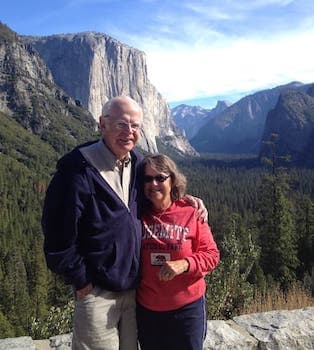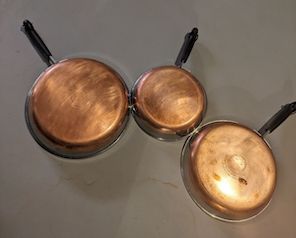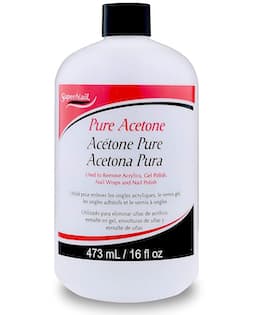
-----
How to remove clearcoat on copper pots & pans
Q. Hi, I just bought a set of pots with copper bottoms at a liquidation sale and just noticed that I need to remove the lacquer coating before using. I found your question on the internet. I was wondering what method you used and did it work. Thank you.
Judy Rezvani- Glendale California
September 8, 2023
A. Try oven cleaner
⇦ on
eBay or
Amazon [affil link] or Marlena Baker's solution or
Acetone
⇦ on
eBay
or
Amazon
[affil link] Flammable!
mixed with ammonia
⇦ on
eBay or
Amazon [affil link] (1 part ammonia 3-5 parts acetone) can be used too. Hope it helps and good luck.
- Cerovsski vrh Croatia
September 13, 2023
Ed. note -- Readers: remember that acetone is flammable. Do this outside.
⇩ Related postings, oldest first ⇩
Q. I have obtained two pieces of copper (outside) over stainless steel cookware. These are coated with ?. I tried to remove it with nail polish remover and elbow grease, but that's not working. What will remove this coating?
It is a clear coating to prevent tarnish. I've received emails that mild detergent will remove this coating, ha, they're wrong.
The skillet is a piece of Revere ware produced in the late 1970's. It is stainless steel covered with copper on the outside. To protect and keep it from tarnishing the company used ? to coat it. So this coating has been on this piece of cookware for over 20 years. I do not want to display this but use it. So I need to remove the coating. I have two other pieces like this that I bought in the 70's but can't remember what I used on the coating. Hope this helps.
P. London- York, Pennsylvania
2002
A. This is from Revere's website taken directly from the warranty. Hope it helps...
"To remove protective coating:
• In pot large enough to immerse at least half of this item, combine 1 tblsp.
baking soda [in bulk on
eBay
or
Amazon [affil link]
to each quart of water used.
• Boil solution. Submerse item in boiling solution and boil for 20-30 minutes. The coating will soften & begin to peel.
• Remove from solution and wash item in warm, soapy water, scrubbing with a Nylon scrubber to remove softened coating. DO NOT use steel wool.
• Finally, clean with copper cleaner (available at supermarkets) and a soft sponge."
- Houston, Texas
Multiple threads merged: please forgive chronology errors and repetition 🙂
Q. I am the owner of a complete set of Revere Limited Edition Copper pots and pans. These are the 1801 signature pans that are completely copper solid copper on the exterior and stainless steel on the inside with solid brass handles.
These pans came with a "durable transparent coating to keep it in perfect condition in transit or when used decoratively" per the original label inside the pan. The label states that "Before using for cooking, this coating must be removed to avoid blackening from heat or flame. Removal is easily accomplished by generously spraying the copper area with such household cleaners as Fantastik, Mr. Clean, Formula 409, etc. Let stand for about two minutes. Coating will start to dissolve. Spray again, then wipe gently with soft sponge or cloth."
What I need to know is what the "durable coating was/is, as I want to have the pans polished and recoated. I know that lacquer is sometimes used however the removal of lacquer in the future is much more difficult than this "durable coating" (what ever it is) and the durable coating works perfectly. I have tried to contact Revere without success. Perhaps one of you or your or someone in your network of contacts actually knows what Revere used for this "durable coating" or where I could have these pans refinished/coated.
Thanks in advance!
Al Hoover- Austin, Texas
2003
A. This coating appears to be a selling point, which means it may be a trade secret that Revere will not reveal, and it's even vaguely possible that it is patented. But if you speak to lacquer experts like G.J. Nikolas [a finishing.com supporting advertiser], I'd be confident that they would be familiar with the process.

Ted Mooney, P.E.
Striving to live Aloha
finishing.com - Pine Beach, New Jersey
Ted is available for instant help
or longer-term assistance.
2003
A. The above companies can also tell you what to strip their coating with and it will be available at your local hardware store.
James Watts- Navarre, Florida
2003
Multiple threads merged: please forgive chronology errors and repetition 🙂
A. How do you know that the coating is still there? I also have a set of Revereware of that vintage. After washing it, I just used it for cooking. Any remaining coating was probably incinerated! If you think the coating is still there because there are darker spots where the copper oxidized over the years (pin holes in the protective layer) and brighter spots where the coating protected it, just remember that the areas that were protected aren't going to oxidize immediately. It will look measled until the protected spots oxidize to match the areas that were unprotected. Also, Revere makes a cleaner*. You could try using that. It has a slight abrasive, but not enough to scratch. Takes the oxidation off the copper parts so you could make it all look the same.
Good luck,
Ronna Erickson- Amherst, Massachusetts
Ed. update: We believe that Revere Copper Cleaner ⇦ on eBay [affil link] has been discontinued. You can still get it on ebay, but probably only at a premium because of its rarity.
A. I have had a set of the all-copper-clad-stainless-lined cookware, since the '70's, as well as many import pieces. In the beginning, we were told to NOT cook with it till the lacquer coating was removed. Cooking would harden the coating and super adhere it in spots - true. To remove that, we boiled the pot in vinegar ⇦in bulk on eBay or Amazon [affil link] -awkward! Recently, polishing the ENTIRE collection, with desperate attitude of the old & cranky, I gave some a shot with spray oven cleaner ⇦ on eBay or Amazon [affil link] . BONANZA! Even 30 yr old lacquer moved! Does NOT hurt the copper! Followed up with a Paste Cleaner (not powder), polishing is fun again!
Becky WymanBeads & Custom Leather - Tacoma, Washington
2004
A. Boiling does work well. If the pot is large, you might have trouble finding a large pot in which to boil it. The finish is a kind of varnish. You can also buy a can of acetone ⇦ on eBay or Amazon [affil link] Flammable! . Take the pot outside and use a rag to apply the acetone. The acetone softens the varnish. Then you can go inside and use Barkeepers Friend ⇦ on eBay or Amazon [affil link] and a pad to clean it up under warm water. The acetone is MUCH quicker than boiling and MUCH easier. Good luck.
Rick Reynolds- McLean, Virginia
A. Hi, This thread and others reveal that the coating may not be so easily removed from 30 year old cookware. Whether that's because the formulation was different 30 years ago, or because the coating has cured for 30 years, the fact is that a more aggressive removal method may be needed on the old stuff.
Regards,

Ted Mooney, P.E.
Striving to live Aloha
finishing.com - Pine Beach, New Jersey
Ted is available for instant help
or longer-term assistance.
2005
Q. I have some unused copper pieces, still finished with a protective surface. I understand that this should be removed before use . I have a gas stove, so the intense heat would burn the finish to the copper.
Karen kellycook - Indian Head,Saskatchewan, Canada
June 29, 2008
A. The tip to use oven cleaner ⇦ on eBay or Amazon [affil link] ! I just added a piece to my set of Revere Copper from the '70s and the new piece had the coating. It came off perfectly! Back in the 70's I was boiling my pans in baking soda, and this was so much easier. Absolutely no damage to the copper! Thanks!
Jan Baratta- Scottsdale, Arizona
April 4, 2010
Q. I just bought a copper pan. The website says it is treated with lacquer and needs to be wiped with acetone
⇦ on
eBay
or
Amazon
[affil link] Flammable!
before first use.
I have done that - using nailpolish remover - however there was not really much of a reaction - I was expecting some stickiness or a layer of something to be removed. I want to be sure that if there is something there that I remove it properly so I don't ruin the copper when I use it.
So, my question, how can I tell if the lacquer is removed, or for that matter, even there in the first place?
Thanks!
- Bonn Germany
August 21, 2011
A. `Hi, Liza
This may not be the right answer for you or Ronna, but it may help somebody. Copper is electrically conductive and lacquer is not; so, you can touch the probes of an inexpensive VOM multimeter ⇦ on eBay or Amazon [affil link] at a few different spots to determine if the lacquer has been removed. Good luck.
Regards,

Ted Mooney, P.E.
Striving to live Aloha
finishing.com - Pine Beach, New Jersey
Ted is available for instant help
or longer-term assistance.
A. I used Brake Parts Cleaner ⇦ on eBay or Amazon [affil link] and it was instant. Just brush off the coating with a scrub brush. Do it outside and wear gloves.
Bass W [last name deleted for privacy by Editor]- Rome, Georgia, USA
October 20, 2012
Q. Tri-ply Copper cookware *display pieces* heavy lacquer finish both inside and out - warning not to use--can this coating be safely removed?
I am interested in the safest way to remove a commercially applied/ display purposes lacquer from a copper cookware set. Please advise of any successful techniques. Thank you.
John Scully [last name deleted for privacy due to age of posting]- Pittsburgh, Pennsylvania, USA
October 9, 2011
A. I wouldn't use it considering the warning label. When this was clearly designed to never be used, who can say that the lacquer is even the only problem? There is probably a benzotriazole
⇦ on
eBay
or
Amazon [affil link]
or similar treatment, and although this is probably of low toxicity, how do we know there isn't some more toxic material between the metal and the lacquer.
Luck & Regards,

Ted Mooney, P.E.
Striving to live Aloha
finishing.com - Pine Beach, New Jersey
Ted is available for instant help
or longer-term assistance.
A. If the copper pots are not lined with tin or other nonreactive metal, don't cook with them.
Jacques Landreau- Vancouver BC, Canada
October 10, 2023
Multiple threads merged: please forgive chronology errors and repetition 🙂
Q. I have the same problem. Did you find a solution to refinishing the copper pots? Please share if you did. Thanks
Kay Smith- Houston Texas US
November 11, 2015
Multiple threads merged: please forgive chronology errors and repetition 🙂
Q. Someone spayed a copper display item with a can of krylon matte clear sealer to try to protect it. But now it is dark and tarnished. What can I use to get rid of this sprayed-on sealer so that I can RE-POLISH the copper?
Beth smithNo. Venice, Florida- USA
February 14, 2021
A. Hi Beth. Try lacquer thinner ⇦ on eBay or Amazon [affil link] Flammable! first. If that doesn't do it, methylene chloride will if you can still find any (it's very toxic, requiring goggles ⇦ on eBay or Amazon [affil link] & rubber gloves ⇦ on eBay or Amazon [affil link] as a minimum and working outside from upwind). If you can't find a stripper with methylene chloride anymore, or don't want to use it, read on for some other possibilities.
Luck & Regards,

Ted Mooney, P.E. RET
Striving to live Aloha
finishing.com - Pine Beach, New Jersey
Ted is available for instant help
or longer-term assistance.
A. Try 3 parts acetone
⇦ on
eBay
or
Amazon
[affil link] Flammable!
and 1 part ammonia (25%) mixture. Use safety goggles and rubber gloves! Bad smelling but very effective.
Hope it helps and good luck!
- Zagreb Croatia
Q, A, or Comment on THIS thread -or- Start a NEW Thread

